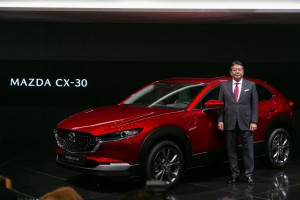
Akira Marumoto, Mazda’s Representative Director, President and CEO, reveals the new CX-30 in Geneva.
Mazda revealed the CX-30 in Geneva, the small crossover it teased last month, saying the new “core model” will be rolled out globally throughout the rest of the year.
The name of the small CUV might be slightly different in the U.S. when it finally arrives in dealerships as the earlier glimpse of the vehicle was called the CX-3. Since in America, Mazda’s alpha-numeric line-up uses just single numbers, such as CX-9 or Mazda6, it’s likely it’ll lose the zero at the end.
Unsurprisingly, it sticks to the Kodo design language that now dominates Mazda’s product portfolio, and Mazda officials said the design team hoped to create a car that would help owners and their families “make new and stimulating discoveries within their daily lives.”
“We designed the CX-30 to be an essential partner in the customer’s life,” said Akira Marumoto, Mazda’s Representative Director, President and CEO. Adding, “it will be made at key global plants so we can deliver Mazda’s renowned driving pleasure and matured Kodo design to customers all over the world.
(Live from Geneva! Click Here for our complete show coverage.)
“Moving forward, our new products and technologies will ensure customers continue to see the value in owning a Mazda car. We aim to be recognized as a brand that forms the strongest of bonds with each customer.”
The small crossover is designed to be big on the inside with room for four adults, making it a full-service utility vehicle. The automaker also took time to give the second-gen model some engine upgrades improving acceleration. The overall ride and handling has been improved as well.
(Click Here for TDB’s first drive in the 2019 Mazda MX-5 Miata.)
The new crossover is a mild hybrid and will be “the first production car to feature Mazda’s innovative SPCCI technology,” the company confirms, a reference to what is more often referred to as the SkyActiv-X engine.
For those not familiar with the “X,” it will become the first production powertrain that can run in homogeneous charge compression mode. Essentially, it uses extremely high compression rates, like a diesel, but runs on gasoline.
(Compact Mazda CUV to break cover in Geneva. Click Here for the story.)
Other automakers have been trying to figure out how to make HCCI work effectively and been stymied. Mazda’s approach is to add a spark plug to ensure the highly compressed fuel-air mixture always ignites at the right time. That’s why it calls its technology SPCCI, or Spark Plug Controlled Compression Ignition. The automaker claims it still can get diesel-like fuel economy, as well as surprisingly good performance, out of the engine.
